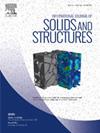Electro-thermal vibration of graphene platelets reinforced functionally graded piezoelectric microplates under different boundary conditions
IF 3.4
3区 工程技术
Q1 MECHANICS
International Journal of Solids and Structures
Pub Date : 2025-02-06
DOI:10.1016/j.ijsolstr.2025.113273
引用次数: 0
Abstract
The paper presents, for the first time, the electro-thermal vibration behavior of novel graphene platelet (GPL)-reinforced functionally graded piezoelectric material (FGPM) microplates under various boundary conditions. The matrix material consists of two piezoelectric materials, with properties varying continuously across the thickness according to a power-law model. The FGPM matrix is reinforced by GPLs in five distribution patterns: symmetric-1 (G1), symmetric-2 (G2), asymmetric-1 (G3), asymmetric-2 (G4), and uniform (G5). The smart microplate model is developed using the four-variable refined plate theory (RPT-4) and modified couple stress theory. Its accuracy and reliability are validated through the Rayleigh-Ritz method, showing excellent agreement with benchmark results. A comprehensive investigation is conducted into the effects of GPL reinforcement, power-law index, boundary conditions, size dependency, side-to-thickness ratio, applied voltage, and temperature rise on the fundamental frequency of the smart microplates.
石墨烯片增强功能梯度压电微板在不同边界条件下的电热振动
本文首次研究了新型石墨烯血小板(GPL)增强功能梯度压电材料(FGPM)微板在不同边界条件下的电热振动行为。基体材料由两种压电材料组成,其性能根据幂律模型在厚度上连续变化。FGPM矩阵由五种分布模式的gpl加强:对称-1 (G1),对称-2 (G2),不对称-1 (G3),不对称-2 (G4)和均匀(G5)。采用四变量精细化板理论(RPT-4)和修正的耦合应力理论建立了智能微孔板模型。通过瑞利-里兹法验证了该方法的准确性和可靠性,与基准结果吻合良好。全面研究了GPL增强、幂律指数、边界条件、尺寸依赖性、边厚比、外加电压和温升对智能微孔板基频的影响。
本文章由计算机程序翻译,如有差异,请以英文原文为准。
求助全文
约1分钟内获得全文
求助全文
来源期刊
CiteScore
6.70
自引率
8.30%
发文量
405
审稿时长
70 days
期刊介绍:
The International Journal of Solids and Structures has as its objective the publication and dissemination of original research in Mechanics of Solids and Structures as a field of Applied Science and Engineering. It fosters thus the exchange of ideas among workers in different parts of the world and also among workers who emphasize different aspects of the foundations and applications of the field.
Standing as it does at the cross-roads of Materials Science, Life Sciences, Mathematics, Physics and Engineering Design, the Mechanics of Solids and Structures is experiencing considerable growth as a result of recent technological advances. The Journal, by providing an international medium of communication, is encouraging this growth and is encompassing all aspects of the field from the more classical problems of structural analysis to mechanics of solids continually interacting with other media and including fracture, flow, wave propagation, heat transfer, thermal effects in solids, optimum design methods, model analysis, structural topology and numerical techniques. Interest extends to both inorganic and organic solids and structures.

 求助内容:
求助内容: 应助结果提醒方式:
应助结果提醒方式:


